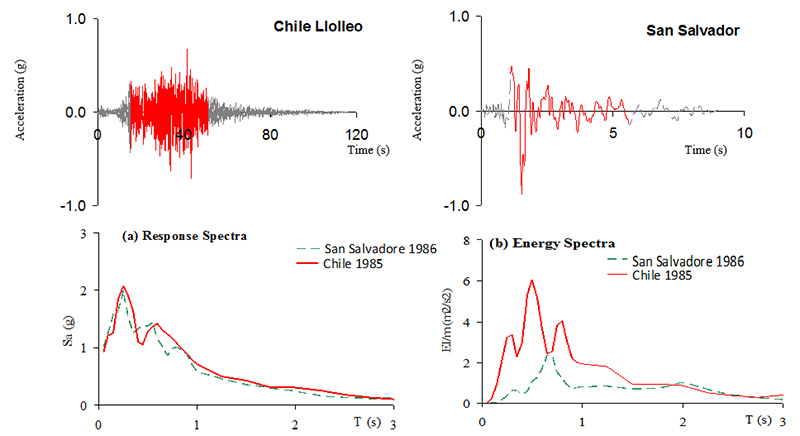

Modern seismic codes such as FEMA 356 (2000), Eurocode, Turkish Seismic Code (2018) etc. suggest force and/or displacement-based design methodologies. However, these procedures do not account for duration related cumulative damage and frequency content of the earthquake record. An energy-based methodology is able to account for these phenomena as well as hysteretic behavior of the structural elements rather than its response envelopes. Moreover, energy is a scalar term whereas displacement and force are vectors.
As shown below, specific earthquake records namely Chile Llolleo 1985 (t = 116.345 sec) and San Salvadore 1986 (t = 9.02 sec) (Uang and Bertero 1988) have quite similar 5% damped acceleration spectra. However, 5% damped input energy per unit mass (EI/m) spectra of the records are vastly different.

The objective of this work is to better characterize energy-based seismic design (EBSD) concept, determine seismic energy demand and the capacity through a comprehensive experimental study.
Two distinct EI/m spectra, which is the principal component of the energy balance equation, based on extensive numerical and experimental studies have been developed. Shake table tests on single degree of freedom (SDOF) systems with diverse natural periods were performed to verify existing and proposed spectral equations.
In this work, damping ratio of the system has been considered as a function of the seismic energy for the first time. It was shown that the spectral velocity, spectral acceleration, corner period, intensity and effective duration of the record were parameters for the seismic energy function
In addition to spectral equations, a piece-wise exact algorithm was developed to solve the seismic energy balance equation instead of predicting it. The proposed piece-wise method is a highly efficient tool for precisely computing the seismic energy.
Multi degree of freedom (MDOF) were performed on the shake table. Energy dissipative steel cushions were also utilized in these tests to supply additional damping.
To study the effect of damping on energy spectra, the damping ratio of the SDOF system was varied from 0.3% to up to 3 % by using a LVDT at the top. These experiments demonstarted that damping may have an important effect on the seismic energy based on the dominant frequencies of the earthquake record. A damping modification factor was proposed for the energy-based spectra.
Since estimation of seismic energy is possible through the proposed framework, it can also be used as an intensity measure, Predictability, efficiency and suffciency of the proposed intensity measure (IEQS) is compared with other measures used by the earthquake engineering community. It was shown that IEQS has a higher correlation with engineering demand parameters (predictability), lower standard deviations (efficiency) and p-values greater than 0.05 (sufficiency) for different types of structures.
Using the proposed piece-wise algorithm, seismic input energy imparted into a MDOF system can be predicted by considering higher mode effects. Higher modes coinciding with the dominant frequencies of the record may result in seismic energy comparable to the first vibrational period. Once the seismic energy is estimated, the peak displacemnet of a MDOF system cna be predicted by a hybrid algorithm developed by the team.
Building upon the findings from prior studies conducted by the research group, an innovative energy-based seismic approach has been formulated. This novel method serves the dual purpose of assessing both the seismic demand and energy dissipation capacities of reinforced concrete (RC) frame members. The developed energy-based design and evaluation method has been applied to analyze a benchmark frame. Furthermore, the research group systematically investigated the correlation between conventional earthquake intensity measures and input and hysteretic energies across various ductility levels. Through rigorous analysis, the group successfully derived predictive models to encapsulate these relationships. The outcomes of this study serve as a central foundation for advancing the development of energy-based seismic hazard maps..
G. Karamese, F. Yardimci, A. Gullu, E. Yuksel, C. Yalcin, and O. Buyukozturk. Vision-Based Dynamic Response Measurements of Structures by Using Smartphone Videos and Alternative Techniques. International Journal of Structural Stability and Dynamics 2022.
C. Yalcin, A.A. Dindar, E. Yuksel, H. Ozkaynak, and O. Buyukozturk. Seismic design of RC frame structures based on energy-balance method. Engineering Structures 2021, 237, 112220.
A. Gullu, E. Yuksel, C. Yalcin, and O. Buyukozturk. Damping effect on seismic input energy and its verification by shake table tests. Advances in Structural Engineering 2021, 24(12), 2669-2683.
A. Gullu, Y. Ercan, C. Yalcin, A. Dindar, H. Ozkaynak and O. Buyukozturk. An improved input energy spectrum verified by the shake table tests. Earthquake Engineering and Structural Dynamics 2019; 48(1): 27-45.
A. A. Dindar, C. Yalcin, E. Yuksel, H. Ozkaynak, O. Büyüköztürk. Development of Earthquake Energy Demand Spectra. Earthquake Spectra 2015; 31(3): 1667-1689.
Back to top